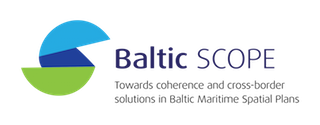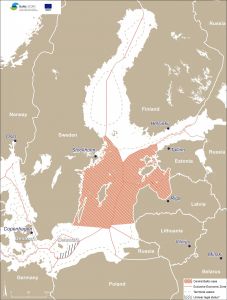The Central Baltic is one of the two case studies pursued in the Baltic SCOPE project. The approach taking in this case is different from the Southwest Baltic Case as the areas and links between the countries and sea borders are different.
The area involves Estonia, Latvia and Sweden and engages planning authorities from these countries responsible for maritime spatial planning:
Estonia
Ministry of Finance
Latvia
Ministry of Environmental Protection and Regional Development
Sweden
Swedish Agency for Marine and Water Management
In the Central Baltic case study area, the Exclusive Economic Zones of Estonia, Latvia and Sweden meet and the territorial waters of Latvia and Estonia meet in the Gulf of Riga.
The area encompasses the Territorial Waters of the countries and includes four major islands: Hiiumaa, Saaremaa Gotland and Öland. Due to the Cold War and restricted areas, Estonia and Latvia first started in the beginning of the 90s to explore ways to economically use the sea. Central Baltic countries face common challenges concerning, for instance, demographic development, economic growth, unemployment (especially among young people) and rural development… Read more
Implications for MSP work across borders
Cross-border cooperation requires multi-level and horizontal interaction of authorities operating at different territorial tiers. However, as expressed as one of the starting considerations for the Baltic SCOPE project, discussions around maritime spatial planning is already relatively well developed in the Baltic Sea Region compared to other European sea basins. At pan-Baltic level there are organisations such as HELCOM and VASAB contributing to the collaborations among national MSP authorities and to the integration of planning efforts… Read more
Conclusions on the preparatory phase
During this phase the project has achieved the following:
- Initiated the exchange of information between countries involved regarding the MSP status, legal background and process in each country.
- Discussed and identified the topics that are most relevant to work with from a transboundary perspective. This has been done through developing topic papers which have been based on input from sector authority’s in the countries.
- Produced a number of maps regarding shipping and socio-economic evidence as well as started worked on compiling energy maps.
- Discussed the ecosystem-based approach and how to apply it in MSP. A task force was set up to handle issues related to ecosystem-based approach.
- Identified and discussed the geographical areas to be considered when discussing planning solutions.
- Done an inventory of national and regional data relevant for achieving coherent MSP among countries.
- Looked into experiences gained from land-based planning and cross-border cooperation.
- Compiled information about the national maritime spatial planning systems.
- Agreed on how to organise the work ahead (e.g. regarding stakeholder involvement)
In parallel with the activities of Baltic SCOPE, each partner country were undertaking consultations with the purpose of feeding into the national MSP process. The approach for stakeholder involvement in each country was rather different.
In most cases, only relevant public agencies and authorities have been involved, yet in some cases other actors were invited to participate. The involvement of non-governmental bodies varies significantly between countries. The setting in which these gathering had taken place also differs in each country; in some cases, involvement was more extensive and detailed than in others… Read more
Transboundary process of Stakeholder involvement into the activities of Baltic SCOPE
Stakeholder involvement in the Central Baltic case during the identification phase has taken place in two ‘Thematic Meetings’ and will be complemented with a larger ‘Stakeholder Conference’ in June, 2016 during the solution phase. The two thematic meetings were organised on sectoral basis, four expert groups composed by experts from Estonia, Latvia and Sweden, one for each of the sectors, including fisheries, energy, environment and shipping. These groups discussed the content from the point of view of the states and compared the differences between countries … Read more
Conclusions on the identification phase
Some of the main results of the identification phase include:
- Involvement of relevant stakeholders in the project, mainly authorities and relevant agencies, who provided valuable insights to be considered during planning processes, also relevant in a transboundary context.
- Transboundary issues were discussed on domestic stakeholder involvement processes;
- Identified sectoral synergies and conflicts based on available knowledge and information gathered during the earlier phases of the project;
- Learned more detailed differences about the methods and tools as well as regulations used in each partner country to define buffer zones, protected areas, and the like.
- Identified issues that need a pan-Baltic perspective within the four sectors (environment, fisheries, shipping, energy);
- Established links with other projects: i.e. BaltSpace and BalticLines.
Information will follow
The discussion process is organized through the planners, partner and stakeholder meetings.
Please see below the meetings which were held and consult the content by clicking ‘read more’:






